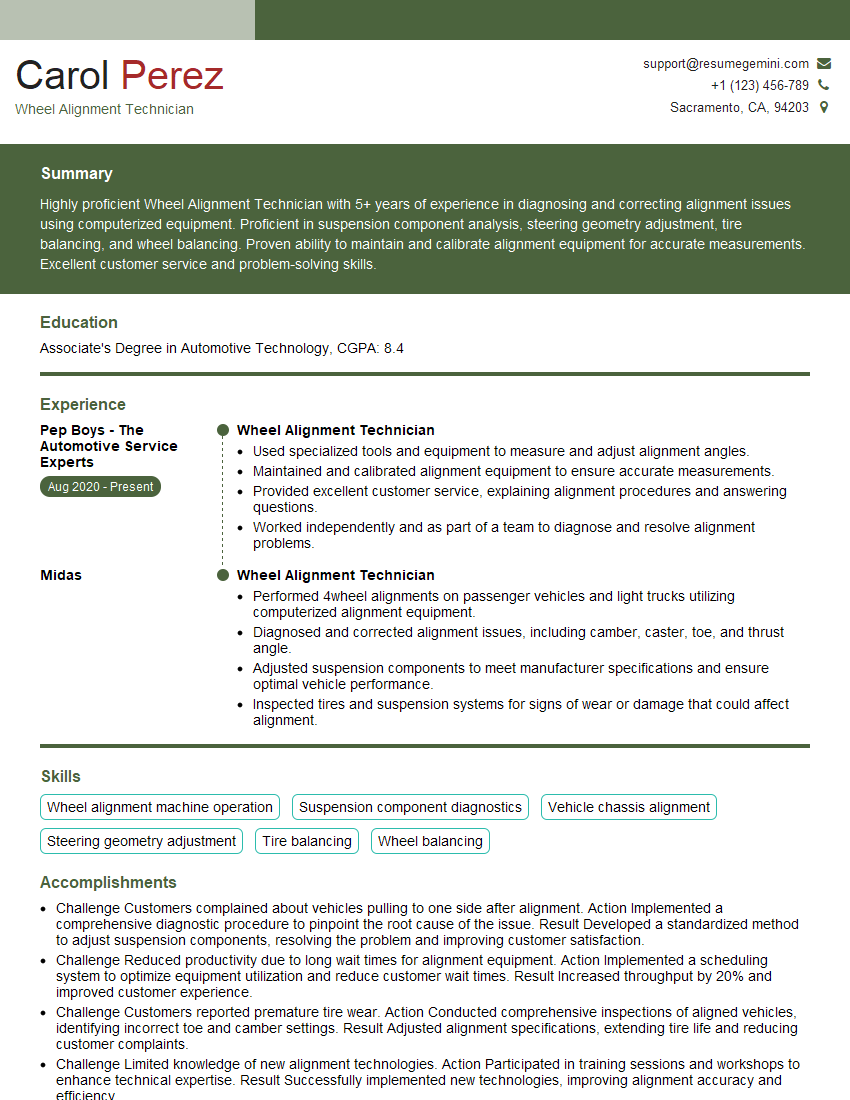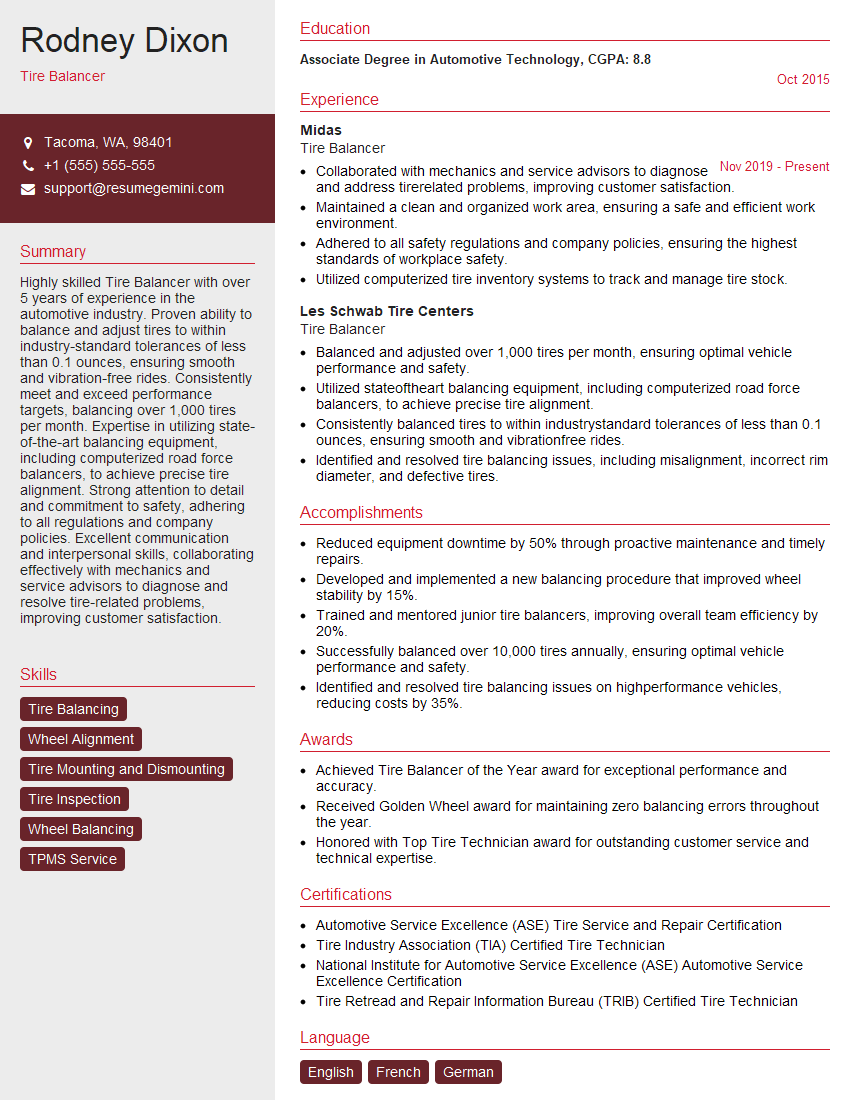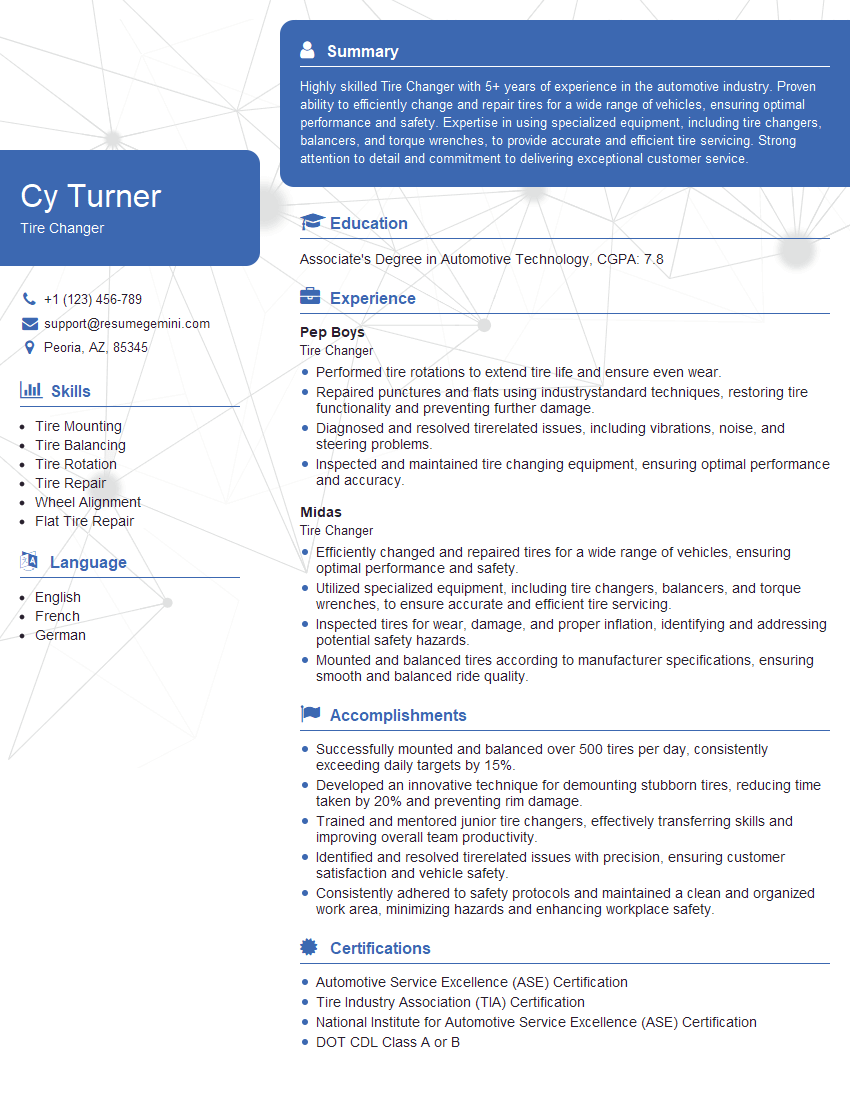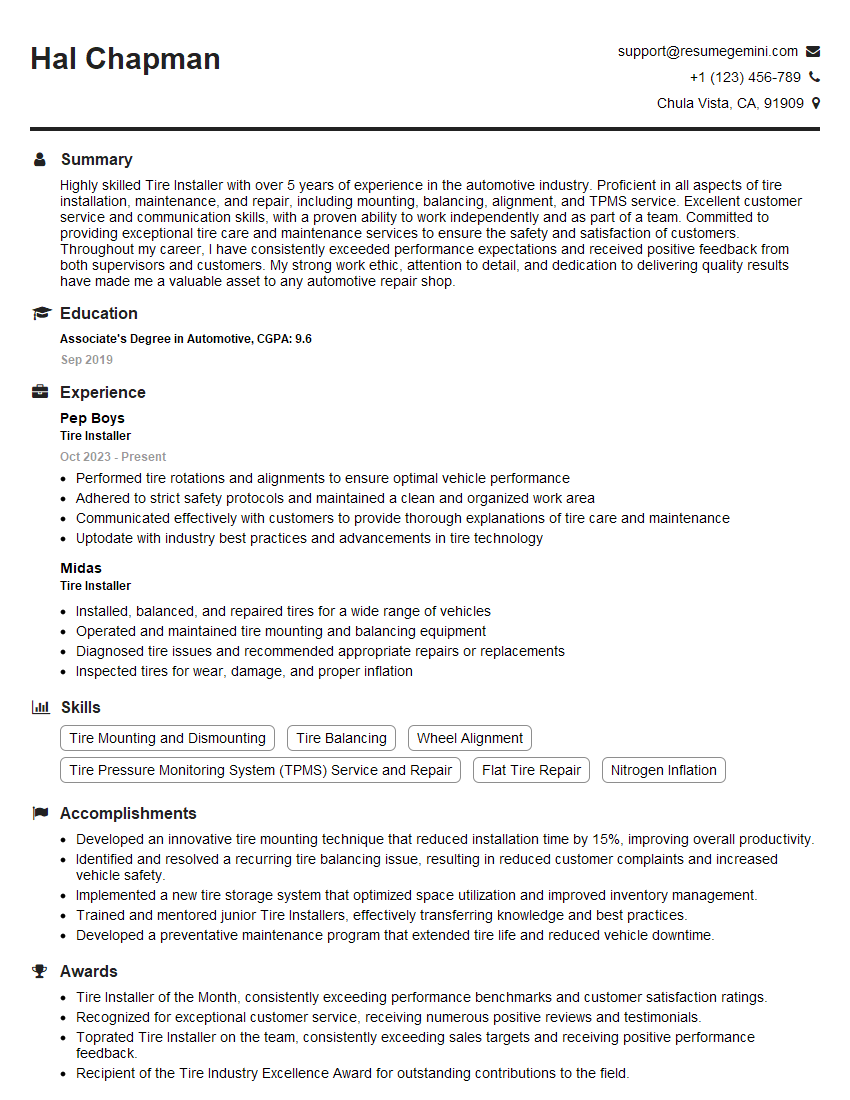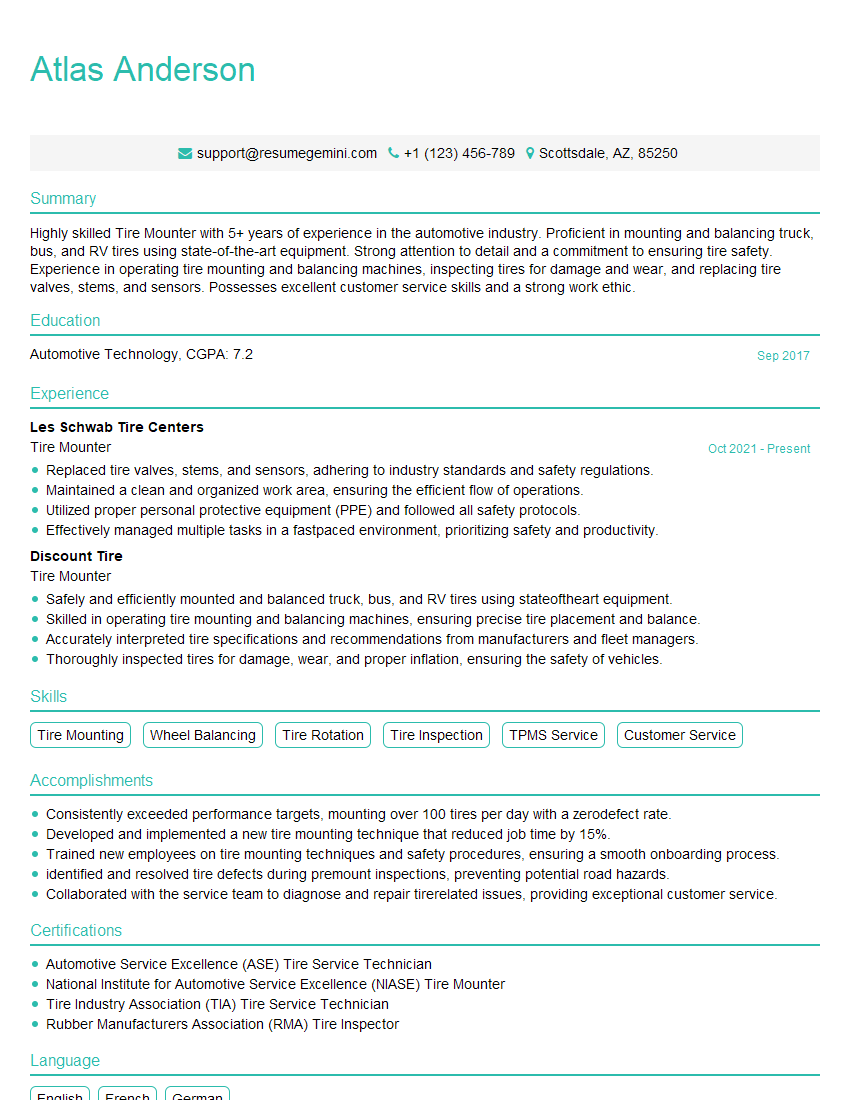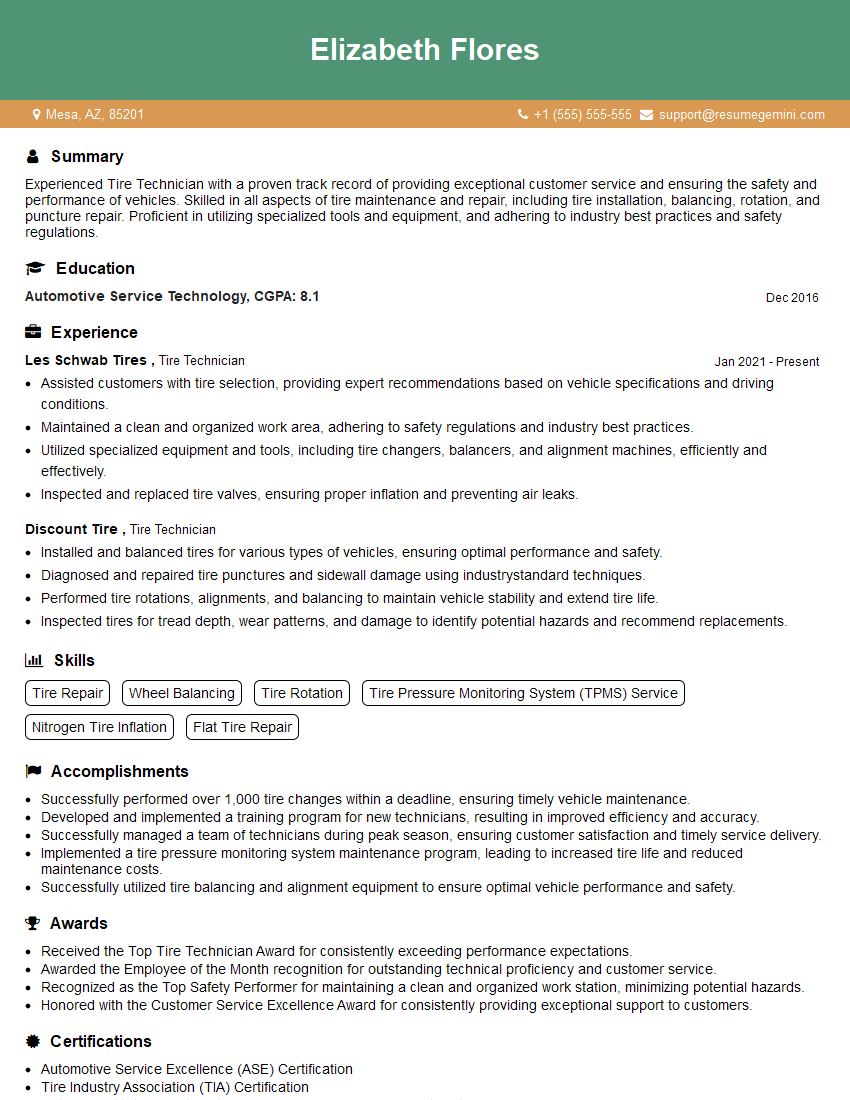Every successful interview starts with knowing what to expect. In this blog, we’ll take you through the top Tire Replacement interview questions, breaking them down with expert tips to help you deliver impactful answers. Step into your next interview fully prepared and ready to succeed.
Questions Asked in Tire Replacement Interview
Q 1. Explain the process of mounting a tire onto a wheel.
Mounting a tire onto a wheel is a crucial step in tire replacement, requiring precision and the right tools. It involves securely attaching the tire to the wheel rim, ensuring a proper and airtight seal.
- Preparation: First, inspect both the tire and the wheel for any damage. Ensure the wheel is clean and free of debris.
- Tire Mounting Machine: Most professionals use a tire mounting machine for this process. This machine helps safely and efficiently seat the tire bead onto the wheel rim.
- Bead Seater: The machine’s bead seater helps push the tire bead over the wheel rim. This is a crucial step to avoid damaging the tire or the wheel.
- Inflation: Once the beads are seated, the tire is partially inflated. This inflates the tire just enough so that it sits properly on the wheel rim.
- Final Inflation and Inspection: Finally, the tire is inflated to its recommended pressure. A final visual inspection is performed to ensure the tire is mounted correctly and there are no issues.
Imagine it like fitting a snug lid onto a jar – it needs to be done correctly to avoid leaks (in this case, air leaks) and ensure a secure fit.
Q 2. Describe the procedure for balancing a tire.
Balancing a tire is essential for a smooth and safe ride. An unbalanced tire causes vibrations that can damage your vehicle’s suspension and steering components, impacting handling and fuel efficiency. The goal of balancing is to distribute the weight of the tire and wheel assembly evenly.
- Mounting on Balancing Machine: The tire and wheel assembly is mounted onto a computerized balancing machine.
- Spin Test: The machine spins the wheel, identifying any weight imbalances. These imbalances are shown on a digital display.
- Weight Placement: Small weights, either clip-on or stick-on, are affixed to the wheel rim at precise locations determined by the machine to counter the imbalances.
- Re-spin and Verification: After the weights are added, the wheel is spun again to verify that it is balanced. The process is repeated until the balance is within the acceptable range.
Think of it like balancing a seesaw: you need to add weight to the lighter side to make it even.
Q 3. How do you identify a tire that needs replacement?
Identifying a tire needing replacement is crucial for safety and vehicle performance. Several factors point towards this.
- Tread Depth: Use a tread depth gauge or the penny test (insert a penny into the tread; if Lincoln’s head is completely visible, it’s time for new tires).
- Uneven Wear: If one area of the tire is significantly worn compared to others, it may indicate an alignment issue or other problem requiring attention.
- Sidewall Damage: Cuts, bulges, or cracks in the sidewall compromise the tire’s structural integrity and should lead to immediate replacement.
- Age: Tires age and degrade over time, regardless of tread depth. Check the sidewall for the manufacturing date (a four-digit code indicating the week and year).
- Cracks or Damage: Inspect for any cuts, cracks, or embedded objects in the tire’s tread or sidewalls.
Ignoring these signs can lead to dangerous situations, such as blowouts.
Q 4. What are the common causes of tire punctures?
Tire punctures are a common occurrence caused by various factors.
- Road Debris: Sharp objects like nails, screws, glass, and metal fragments are frequent culprits. These items can easily penetrate the tire’s rubber.
- Potholes and Sharp Objects: Driving over potholes or hitting curbs can cause damage to the tire sidewall, leading to a puncture.
- Manufacturing Defects: Although rare, manufacturing defects can sometimes weaken the tire, making it more susceptible to punctures.
- Underinflation: Driving on underinflated tires increases the risk of punctures because the tire sidewalls are more prone to damage.
Imagine stepping on a sharp object with your bare foot – the same principle applies to your tires.
Q 5. Explain different tire types and their applications.
Different tire types cater to specific vehicle types and driving conditions.
- Passenger Car Tires: Designed for comfort, fuel efficiency, and a balance of handling and ride quality.
- Light Truck Tires: Built for heavier loads and tougher conditions; they generally offer more robust sidewalls and tread patterns for off-road capabilities.
- High-Performance Tires: Optimized for better grip, handling, and responsiveness, typically found on sports cars.
- All-Season Tires: Provide a compromise between summer and winter performance, suitable for moderate weather conditions.
- Winter Tires: Designed for snow and ice, featuring special tread patterns and rubber compounds.
Choosing the right tire is crucial for safety and optimal performance – like choosing the right shoes for a specific activity.
Q 6. How do you inspect a tire for damage?
Inspecting a tire for damage is a critical safety check. It should be done regularly.
- Visual Inspection: Examine the entire tire, including the tread, sidewalls, and shoulder areas, for any cuts, cracks, bulges, or embedded objects. Look for irregular wear patterns.
- Tread Depth Check: Use a tread depth gauge or the penny test to check the remaining tread depth. Insufficient tread compromises traction and braking.
- Sidewall Examination: Carefully examine the sidewalls for any cracks, cuts, bulges, or deformities. These indicate structural damage.
- Check for Embedded Objects: Look for any embedded objects, such as nails or screws, that may have punctured the tire.
A thorough inspection ensures early detection of potential problems that could lead to a tire failure.
Q 7. What safety precautions do you take while working with tires?
Safety is paramount when working with tires. Several precautions must be taken.
- Proper Equipment: Use appropriate tools such as tire irons, mounting machines, and air compressors, ensuring they are in good working order.
- Eye Protection: Always wear safety glasses to protect your eyes from debris or sudden pressure changes.
- Gloves: Wear gloves to protect your hands from cuts and abrasions.
- Proper Inflation: Never overinflate a tire, and always follow manufacturer’s recommendations.
- Safe Handling: Use proper lifting techniques to avoid injury. Tires can be heavy and unwieldy.
- Ventilation: Work in a well-ventilated area when using compressed air or other chemicals.
Safety should be your top priority; even a seemingly minor mishap can have serious consequences.
Q 8. How do you handle a tire with a sidewall bulge?
A sidewall bulge indicates structural damage to the tire, rendering it unsafe for use. The tire’s internal structure has been compromised, often due to impact damage or excessive pressure. This bulge weakens the sidewall, increasing the risk of a blowout, which can lead to loss of control and accidents. Never attempt to repair a tire with a sidewall bulge. It must be replaced immediately. Think of it like a crack in a foundation – you wouldn’t patch it; you’d need to rebuild that section. Replacing the tire is the only safe course of action.
Q 9. Describe the process of repairing a tire puncture.
Repairing a tire puncture involves several steps. First, thoroughly inspect the tire to locate the puncture and assess its severity. Small punctures in the tire tread, not the sidewall, are usually repairable. The tire must be removed from the rim. Then, using a tire plug kit, a specialized tool inserts a tough rubber cord into the puncture, sealing it from the inside. The process often involves a reamer tool to slightly widen the hole to ensure a good seal. After plugging, the tire is re-inflated and visually inspected for any air leakage. If the repair holds pressure, the tire can be re-mounted on the rim and rebalanced. However, even successful repairs can weaken the tire, so it’s always best to consult a professional tire technician for a proper assessment and repair. Remember, sidewall punctures are never repairable.
Q 10. What tools are essential for tire replacement?
Essential tools for tire replacement include:
- Tire Iron/Lug Wrench: To loosen and tighten lug nuts securing the wheel to the vehicle.
- Jack: To safely lift the vehicle and provide access to the tire.
- Jack Stands (highly recommended): To securely support the vehicle while the tire is changed, preventing it from falling.
- Wheel Chocks: To prevent the vehicle from rolling while it’s jacked up.
- Gloves: To protect your hands from dirt and potential injury.
- Optional: Torque wrench (to tighten lug nuts to the manufacturer’s specified torque), and a lug nut socket that fits your car.
Having the correct size and type of lug wrench for your vehicle is crucial. Trying to use an ill-fitting tool can damage the lug nuts or your hands.
Q 11. How do you ensure proper inflation pressure?
Proper inflation pressure is critical for optimal tire performance, fuel efficiency, and safety. The recommended pressure is usually found on a sticker located inside the driver’s side doorjamb, or in your owner’s manual. It’s also printed on the tire sidewall, but this is the maximum pressure and may not be the recommended pressure for your vehicle’s weight and load. Use a reliable tire pressure gauge to check the pressure. Inflate tires to the recommended pressure, not the maximum pressure listed on the sidewall. Remember to check tire pressure regularly, ideally once a month or before long trips, as pressure can fluctuate due to temperature changes.
Q 12. Explain the concept of wheel alignment and its relation to tires.
Wheel alignment refers to the precise adjustment of angles in your vehicle’s suspension system. These angles affect how the tires contact the road surface. Proper alignment ensures that the tires roll straight and smoothly, minimizing uneven wear and maximizing tire life. Misalignment can cause your tires to wear out prematurely on one side or the other, leading to increased fuel consumption, and a less responsive steering feel. Imagine walking with your feet pointed outwards: you’d waste energy and quickly tire out. It’s similar to misaligned wheels.
Q 13. What is the importance of tire rotation?
Tire rotation involves periodically changing the position of tires on your vehicle. This helps distribute wear evenly across all tires, prolonging their lifespan and enhancing overall performance. For example, a common pattern is to move the front tires to the rear and vice-versa. Without rotation, tires on the front axle, which typically bear more stress during acceleration and braking, wear out much faster than the rear tires. Regular rotation, based on the manufacturer’s recommendations or the tire’s condition, ensures a more balanced wear pattern, saving you money in the long run.
Q 14. How do you deal with a customer who disputes a tire repair or replacement?
Handling customer disputes requires patience, empathy, and a professional approach. First, listen carefully to the customer’s concerns and try to understand their perspective. Review the relevant documentation, such as service orders or repair records. If possible, demonstrate your process and explain the technical aspects of the repair or replacement clearly and concisely, avoiding technical jargon. Offer a fair solution, whether it’s a partial refund, a replacement tire, or a further inspection by a senior technician. If the disagreement persists, consider offering alternative dispute resolution methods, such as a mediation process. Maintaining a calm and professional demeanor throughout the process is essential to preserving the customer relationship.
Q 15. What are the signs of improper tire inflation?
Improper tire inflation is a significant safety hazard and can lead to premature tire wear. Signs of underinflation include a noticeably softer tire, the tire bulging near the sidewalls, and a wider contact patch with the road. You might also notice a decrease in fuel efficiency and handling responsiveness. Overinflation, conversely, results in a harder tire, a smaller contact patch, and a potential for a bumpy ride. The tire may appear rounder than usual, and the risk of a blowout increases. You can easily check your tire pressure with a reliable gauge and compare it to the recommended pressure listed on the tire sidewall sticker (usually located on the driver’s side doorjamb) or in your owner’s manual.
Example: Imagine a basketball; underinflated, it’s flat and difficult to bounce, while overinflated, it’s hard and prone to bursting. Tires behave similarly.
Career Expert Tips:
- Ace those interviews! Prepare effectively by reviewing the Top 50 Most Common Interview Questions on ResumeGemini.
- Navigate your job search with confidence! Explore a wide range of Career Tips on ResumeGemini. Learn about common challenges and recommendations to overcome them.
- Craft the perfect resume! Master the Art of Resume Writing with ResumeGemini’s guide. Showcase your unique qualifications and achievements effectively.
- Don’t miss out on holiday savings! Build your dream resume with ResumeGemini’s ATS optimized templates.
Q 16. Explain the different types of tire tread patterns.
Tire tread patterns are designed to optimize different aspects of performance, such as traction, water evacuation (hydroplaning resistance), and noise reduction. There isn’t a single definitive classification, but some common patterns include:
- Symmetrical: The tread pattern is identical on both sides of the tire’s centerline. This offers good all-around performance and is often found on passenger vehicles.
- Asymmetrical: The tread pattern differs on either side of the centerline. One side is usually optimized for dry handling, while the other focuses on wet grip. This design provides superior performance in varied conditions.
- Directional: The tread pattern is designed to rotate in a specific direction, indicated by arrows on the sidewall. These tires excel in water evacuation, reducing the risk of hydroplaning, but require rotation in a specific direction.
- Uni-directional: Similar to directional but usually with more emphasis on specific performance traits over others.
Example: A sporty car might utilize asymmetrical tires for superior cornering grip, whereas an SUV may use symmetrical tires for balanced all-weather performance.
Q 17. How do you interpret tire sidewall markings?
Tire sidewall markings are crucial for understanding a tire’s specifications. They provide information such as:
- Tire Size: (e.g., 225/55R17) indicating width, aspect ratio, construction type, and rim diameter.
- Load Index: A numerical code representing the maximum load capacity of the tire at its maximum inflation pressure.
- Speed Rating: A letter representing the maximum safe speed the tire can sustain. (e.g., H, V, W)
- Manufacturer Information: Identifying the tire manufacturer and specific model.
- Treadwear, Traction, and Temperature Ratings (UTQG): Three numerical ratings indicating the expected tread life, traction ability on wet surfaces, and heat resistance.
- Other Markings: Such as M+S (Mud and Snow) indicating all-season or winter capabilities, or RF (Run-Flat) for tires designed to operate even after a puncture.
Example: 225/55R17 97V indicates a tire with a 225mm width, 55% aspect ratio, 17-inch rim diameter, a load index of 97, and a speed rating of V (149 mph).
Q 18. What are the common causes of uneven tire wear?
Uneven tire wear is often a sign of underlying mechanical problems. Common causes include:
- Improper Inflation: Underinflation causes excessive wear on the outer edges, while overinflation leads to wear in the center.
- Wheel Alignment Issues: Toe-in (wheels pointing inwards), toe-out (wheels pointing outwards), or camber (wheels tilted) cause uneven wear patterns.
- Suspension Problems: Worn shocks, struts, or other suspension components can affect tire contact with the road.
- Brake System Issues: A dragging brake caliper can cause excessive wear on one side of a tire.
- Uneven Weight Distribution: An overloaded vehicle or a persistently heavy load on one side can contribute to uneven wear.
Example: Feathering (a zig-zag pattern) on the tire tread is often indicative of improper toe alignment.
Q 19. What is the proper torque specification for lug nuts?
The proper torque specification for lug nuts is crucial for wheel security and safety. It varies significantly depending on the vehicle, wheel type, and lug nut size. Never attempt to tighten lug nuts using your own judgment. Always consult your vehicle’s owner’s manual for the recommended torque specification. This information is typically found in the maintenance section. Use a torque wrench to ensure accurate tightening. Over-tightening can strip the threads, while under-tightening can cause the wheel to come loose.
Example: A typical torque range might be between 80 and 100 foot-pounds, but this varies greatly depending on the vehicle. Using a torque wrench ensures that the lug nuts are tightened to the manufacturer’s specifications.
Q 20. How do you dispose of used tires responsibly?
Responsible disposal of used tires is essential to protect the environment. Do not simply discard them in landfills. Many municipalities offer tire recycling programs, where tires can be collected and repurposed or properly disposed of. Some tire retailers also accept used tires for recycling or disposal. You can find local tire recycling facilities through online searches or by contacting your local waste management department. Several options exist, including retreading (reusing the tire carcass), tire-derived fuel (using tires as an energy source), and conversion into other products like rubber mulch.
Example: Check your local government’s website for a list of approved tire disposal locations or contact a local auto parts store to inquire about their recycling program.
Q 21. Describe your experience with different types of tire repair equipment.
Throughout my career, I’ve worked extensively with various tire repair equipment, from basic tools to sophisticated machinery. My experience includes:
- Tire Changers: I’m proficient in using both manual and automated tire changers to efficiently and safely mount and demount tires from rims. This includes understanding the proper techniques to avoid damaging the rims or tires.
- Wheel Balancers: I’m skilled in using wheel balancers to accurately determine the weight distribution of mounted tires and wheels. This ensures smooth operation and prevents vibrations.
- Tire Pressure Gauges: I routinely use various types of tire pressure gauges to accurately measure and maintain proper tire inflation.
- Tire Repair Kits: I have experience with plug kits and patch kits for repairing punctures in tires, understanding the limits of these repairs and when a tire replacement is necessary.
- Specialized Equipment: In certain settings, I have used more specialized equipment such as bead breakers and tire bead seating machines.
Example: When using a tire changer, knowing the proper techniques to protect the wheel rim from scratching is paramount. I always use the appropriate mounting tools for the rim type and never apply excessive force.
Q 22. Explain how to use a tire pressure gauge accurately.
Accurately using a tire pressure gauge is crucial for maintaining optimal tire performance and safety. Think of it like checking your blood pressure – you need the right tool and technique for an accurate reading.
First, ensure the gauge is properly calibrated. Many gauges have a small button or valve to release any existing pressure before use. Next, firmly attach the gauge to the tire valve stem, pressing it on securely. Avoid tilting or moving the gauge during the measurement. The needle will move, indicating the pressure. Compare this reading to the recommended tire pressure found on the sticker inside your driver’s side doorjamb or in your vehicle’s owner’s manual. Remember, the pressure should be checked when the tires are cold (meaning they haven’t been driven on for at least three hours).
For example, if your gauge reads 30 PSI (pounds per square inch) and your vehicle requires 32 PSI, you’ll need to add 2 PSI to each tire using a quality air compressor. Always add air in small increments, rechecking the pressure frequently to avoid overinflation. Overinflation can compromise tire longevity and handling, while underinflation reduces fuel efficiency and increases wear.
Q 23. How do you identify a tire with a broken belt?
Identifying a broken tire belt requires a keen eye and often involves visual inspection, supported by careful palpation (feeling). A broken belt usually manifests as a bulge or a lump on the tire’s sidewall. This bulge indicates that the internal belts, which provide structural integrity, have separated or broken. The affected area may also feel softer or more pliable than the surrounding tire.
Sometimes, a broken belt isn’t easily visible. If you suspect a problem, you may need to run your hand along the sidewall, feeling for any irregularities. If you find a bulge, that tire needs immediate replacement. It’s important to note that a broken belt compromises the structural integrity of the tire significantly, posing a serious safety risk. Driving on a tire with a broken belt can lead to tire failure, which can cause loss of control and accidents.
Imagine it like a rip in a canvas tent. If the supporting threads break, the whole structure weakens. Similarly, a broken tire belt puts the entire tire at risk of failure.
Q 24. What is your experience with different types of tire sealant?
My experience encompasses various tire sealants, each with its pros and cons. Generally, sealants are temporary solutions for small punctures, not replacements for proper tire repairs. They come in different forms: liquid sealants, which are injected into the tire, and aerosol spray-on sealants. Liquid sealants are often more effective for larger punctures and can seal from the inside, but require a sealant injection tool. Spray-on sealants are convenient for smaller holes but tend to be less effective on larger punctures or if the tire is already severely damaged.
I’ve worked with several brands, and my personal preference leans towards liquid sealants for their more effective sealing capabilities. However, I always advise the customer that it is a temporary fix and professional assessment and repair are still needed. I inform them that this sealant may not work on larger punctures and should not be a substitute for regular tire maintenance and replacement when necessary. Sealants can sometimes create issues with Tire Pressure Monitoring Systems (TPMS) as well. Choosing the right sealant depends heavily on the size and location of the puncture.
For example, I once had a customer come in with a slow leak. After identifying a small puncture, I used a liquid sealant injection. It worked temporarily and I was able to find a new tire for them while they used their temporary patched tire to get them through the work day, however I emphasized the need for a professional replacement as soon as possible.
Q 25. How would you handle a situation where a tire bead won’t seat properly?
A tire bead that won’t seat properly is a common problem. The tire bead is the edge of the tire that sits on the wheel rim. A properly seated bead ensures an airtight seal, essential for maintaining tire pressure and safety. Several factors can prevent proper seating, such as a damaged tire bead, a rusty or damaged wheel rim, insufficient inflation, or incorrect bead lubricant use.
My troubleshooting process begins with a visual inspection of both the tire and the wheel rim for any damage. I then use a bead lubricant, such as soapy water, to help the bead slide onto the rim. Next, I carefully inflate the tire using an air compressor, while ensuring that the tire valve is correctly installed and air is not escaping elsewhere. Sometimes, the tire bead can be stubborn and a bead breaker tool may be necessary to gently help it over the rim.
If the bead still won’t seat, I check the wheel rim for any damage, like corrosion or deformation. A damaged rim can prevent the bead from seating properly. In such cases, I might advise the customer that the rim needs repair or replacement. If the problem persists, I would consult with a more senior technician to ensure the safety and efficiency of the process.
Q 26. What are your experience with different types of tire chains?
My experience with tire chains covers various types, including cable chains, V-bar chains, and self-tensioning chains. Each type offers different levels of traction and ease of installation. Cable chains, while lighter, tend to offer less aggressive traction than V-bar chains. V-bar chains, with their cross-chain design, offer superior traction on ice and snow, but can be heavier and more difficult to install. Self-tensioning chains simplify the installation process, ensuring proper tension without the need for frequent adjustments.
The choice of chain depends heavily on the driving conditions and the vehicle. For passenger cars, simpler chains might suffice, while heavier vehicles may benefit from more robust designs. It’s critical to select chains that are appropriate for the tire size and vehicle weight. Incorrect chain selection can cause damage to the vehicle or reduce handling and safety.
I always emphasize the importance of following manufacturer instructions when installing and using chains. Improper installation can lead to chain damage or dangerous driving conditions. I also explain to customers that chains should only be used in snowy or icy conditions and removed once these conditions subside. Continuous use of chains on dry pavement can cause damage to both the chains and the tires.
Q 27. Describe your process for diagnosing tire problems based on customer complaints.
Diagnosing tire problems starts with carefully listening to the customer’s description of the issue. Do they report unusual sounds, vibrations, handling difficulties, or changes in tire pressure? This initial conversation provides vital clues. I then perform a thorough visual inspection of the tires, examining them for any signs of damage such as punctures, bulges, tread wear irregularities, cuts, or sidewall damage. I check the tire pressure, comparing it to the recommended pressure. I may even perform a ‘bounce test’ to check for any signs of broken belts.
Next, I might examine the vehicle’s wheel alignment, as poor alignment can lead to uneven tire wear. Based on the findings of this visual and physical inspection, I offer potential solutions. If the problem is minor, like low tire pressure, I can address it directly. For more complex problems, such as a puncture or uneven wear, I will advise further steps or possible repairs.
For example, a customer reporting a thumping sound while driving might suggest a problem with a tire balance or a damaged tire. A customer describing poor handling or excessive pulling might indicate a wheel alignment issue or uneven tire wear.
Q 28. How do you maintain your tire changing equipment?
Maintaining tire-changing equipment is crucial for safety and efficiency. This includes regular cleaning, lubrication, and inspection of all tools and equipment. My process involves cleaning all tools after each use, removing any debris or dirt. I regularly inspect the tire changer for any signs of wear and tear, paying special attention to the clamping mechanisms and the bead breakers. Any damaged or worn parts are promptly replaced to ensure safe operation.
I lubricate moving parts, such as the bead breaker and the clamping arms, to prevent rust and corrosion and ensure smooth operation. The air compressor is also regularly serviced, checked for leaks, and the pressure regulator maintained to ensure it provides consistent and safe pressure. I keep a detailed log of maintenance activities to track service schedules and promptly address any potential issues.
Just like a chef meticulously maintains their knives, a tire technician should always maintain their equipment for safety and efficiency. A well-maintained tire changer can save you time, prevents accidents, and ensures a high-quality service.
Key Topics to Learn for Tire Replacement Interview
- Tire Types and Their Characteristics: Understanding different tire constructions (radial, bias-ply), tread patterns, and their impact on performance and safety.
- Wheel and Tire Assembly: Knowledge of proper lug nut torque specifications, wheel balancing techniques, and the detection of damaged wheels or tires.
- Safety Procedures and Protocols: Mastering safe jacking and lifting procedures, proper use of safety equipment (gloves, eye protection), and hazard identification and mitigation.
- Tire Removal and Installation Techniques: Practical understanding of using tire irons, impact wrenches, and other tools for efficient and damage-free tire replacement.
- Troubleshooting Common Issues: Diagnosing problems like flat tires, punctures, and identifying signs of tire wear and tear. Knowing when tire replacement is necessary versus repair.
- Tire Pressure and Inflation: Understanding the importance of maintaining proper tire pressure, using a pressure gauge accurately, and the implications of overinflation or underinflation.
- Regulatory Compliance and Best Practices: Familiarity with industry standards and regulations related to tire disposal and safe handling procedures.
- Customer Service and Communication: Explaining tire options to customers clearly, addressing concerns, and providing excellent customer service.
Next Steps
Mastering tire replacement skills opens doors to diverse and rewarding career opportunities in the automotive industry, offering strong potential for growth and advancement. A well-crafted resume is your key to unlocking these opportunities. Creating an ATS-friendly resume is crucial for getting your application noticed by potential employers. To enhance your resume and significantly improve your chances of landing your dream job, leverage the power of ResumeGemini. ResumeGemini provides a user-friendly platform to build a professional resume, and we offer examples of resumes tailored to the Tire Replacement field to help you get started.
Explore more articles
Users Rating of Our Blogs
Share Your Experience
We value your feedback! Please rate our content and share your thoughts (optional).
What Readers Say About Our Blog
Hi, I’m Jay, we have a few potential clients that are interested in your services, thought you might be a good fit. I’d love to talk about the details, when do you have time to talk?
Best,
Jay
Founder | CEO
